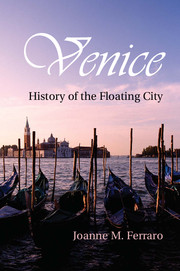Book contents
- Frontmatter
- Contents
- Plates
- Illustrations
- Maps
- Acknowledgments
- Preface
- Chronology of Historical Events
- 1 Reconstructing the Floating City
- 2 The Riches of Asia, Europe, and North Africa
- 3 A Pride of Lions
- 4 Identities and Modes of Socialization
- 5 Material Life
- 6 City of Myth
- 7 The Serenissima’s Wayward Subjects
- 8 The Baroque Stage
- 9 Epilogue
- Appendix I Approximate Population of Venice during the Republic
- Appendix II Population of the Historic Center of Venice, 1871–2010
- Glossary
- Notes
- Bibliography
- Index
- Plate Section
- References
3 - A Pride of Lions
Published online by Cambridge University Press: 05 August 2012
- Frontmatter
- Contents
- Plates
- Illustrations
- Maps
- Acknowledgments
- Preface
- Chronology of Historical Events
- 1 Reconstructing the Floating City
- 2 The Riches of Asia, Europe, and North Africa
- 3 A Pride of Lions
- 4 Identities and Modes of Socialization
- 5 Material Life
- 6 City of Myth
- 7 The Serenissima’s Wayward Subjects
- 8 The Baroque Stage
- 9 Epilogue
- Appendix I Approximate Population of Venice during the Republic
- Appendix II Population of the Historic Center of Venice, 1871–2010
- Glossary
- Notes
- Bibliography
- Index
- Plate Section
- References
Summary
From Dukedom to Commune
The history of the Venetian patriciate is central to the city’s medieval metamorphosis from a scattering of island communities on the fringes of the Byzantine Empire to a major Mediterranean power and Italian regional state. By the tenth century a group of family dynasties held the reins of power. At this time, other parts of Italy were ruled by feudal magnates or bishops, many tracing back to a line of German kings. Venice, on the other hand, followed a different course of political development. Family dynasties kept their independence, remaining oriented toward Byzantine culture and focused on commercial enterprise. Although they embraced the Byzantine model of monarchy with the election of a doge in the eighth century, between the ninth and the thirteenth centuries the position became more ceremonial than real. Instead, competing families with great fortunes in banking and trade rose in status and shaped the course of events.
Dynamic economic expansion in the Adriatic, eastern Mediterranean Sea , and the Levant during the eleventh and twelfth centuries produced marked social dif erentiation at home, distinguishing the most successful families from the rest of the population. The commercial leaders who had strengthened Venice’s power on the seas, subdued the Istrian and Dalmatian coasts, and proi ted from trading privileges with the Byzantine Empire also invested in real estate around the Rivoalto and in the fertile Po Valley. Accumulating great riches, they in turn constructed powerful clientele networks in Venice and dominated high oi ces like the dogeship.
- Type
- Chapter
- Information
- VeniceHistory of the Floating City, pp. 51 - 74Publisher: Cambridge University PressPrint publication year: 2012

